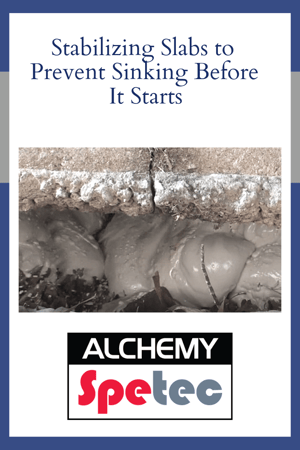
 Slab stabilization and structural void filling can actually be even more valuable than slab lifting. Why wait for a slab to sink, settle, or break, when it can be stopped. Preventative slab stabilization and underslab recompaction (I'm making up words now) is a great way to protect the investment that is the foundation of any home or business.
Slab stabilization and structural void filling can actually be even more valuable than slab lifting. Why wait for a slab to sink, settle, or break, when it can be stopped. Preventative slab stabilization and underslab recompaction (I'm making up words now) is a great way to protect the investment that is the foundation of any home or business.
A good contractor should know how to: spot the signs indicating a possible problem, verify whether a problem exists or not, and repair an unsupported slab that’s in danger of sinking.
How to Spot a Slab That May Be in Danger of Sinking
The most obvious slabs at risk are the ones where a void can be seen from the side. In these instances, the soil on the side has washed away along with significant soil underneath. (See the photo included with this blog post for an example.) Other situations to look out for are slabs on a hill or at the bottom of a hill. Concrete in these locations is likely to have rain water washing under it and eroding the soil. Slabs on level ground aren’t immune from this problem either. Check for gutter downspouts placed very close by, or adjacent structures with no gutter system at all. If a rain water management system wasn’t set up to direct water AWAY from the slab, there may be an issue. Another red flag would be cracks in the concrete.
How to Be SURE a Slab’s in Danger of Sinking
There are many ways to check for voids underneath a slab. Some people tap the slab with a metal tool, or even a golf club. (Others use golf balls, which they bounce off the slab). Whatever the tool, the point is to listen for a hollow ring. This tactic may take some practice at first, but many people use it. Another approach is to drill a small hole, and then check the soil underneath with a soil probe or a penetrometer. I find that the 4’ long fiberglass driveway markers make a nice probe. Endoscope cameras are small enough to stick down through the drill hole and have a look around. On larger jobs, some have arranged for the use of ground penetrating radar.
How to Stabilize a Level Slab in Danger of Sinking
On a void fill/stabilization job, the contractor should set up an even grid pattern across the entire slab. This approach allows for the even distribution of material, as needed. Unlike a lifting job, there’s no need to emphasize one side of the slab versus the other. Instead, the contractor injects the appropriate amount of resin into each hole of the even grid pattern. It’s important to monitor every injection with a zip level or dial indicator and stop at the first sign of any movement. If ANY slight movement happens it’s time to move on to the next hole. These tools allow for the detection of movement as small as 100th of inch, which isn’t a visible lift to the naked eye. For more on stabilizing slabs, see the blog post Slab Void Fill with Polyurethane Foam.
Wrap Up
No property owner should assume that their slab is safe just because it isn’t sinking yet. It’s better to know the danger signs and call a qualified professional to check it out. In addition, contactors should always keep an eye out for concrete in vulnerable situations. Remember: just because it’s level doesn’t mean it’s safe.


